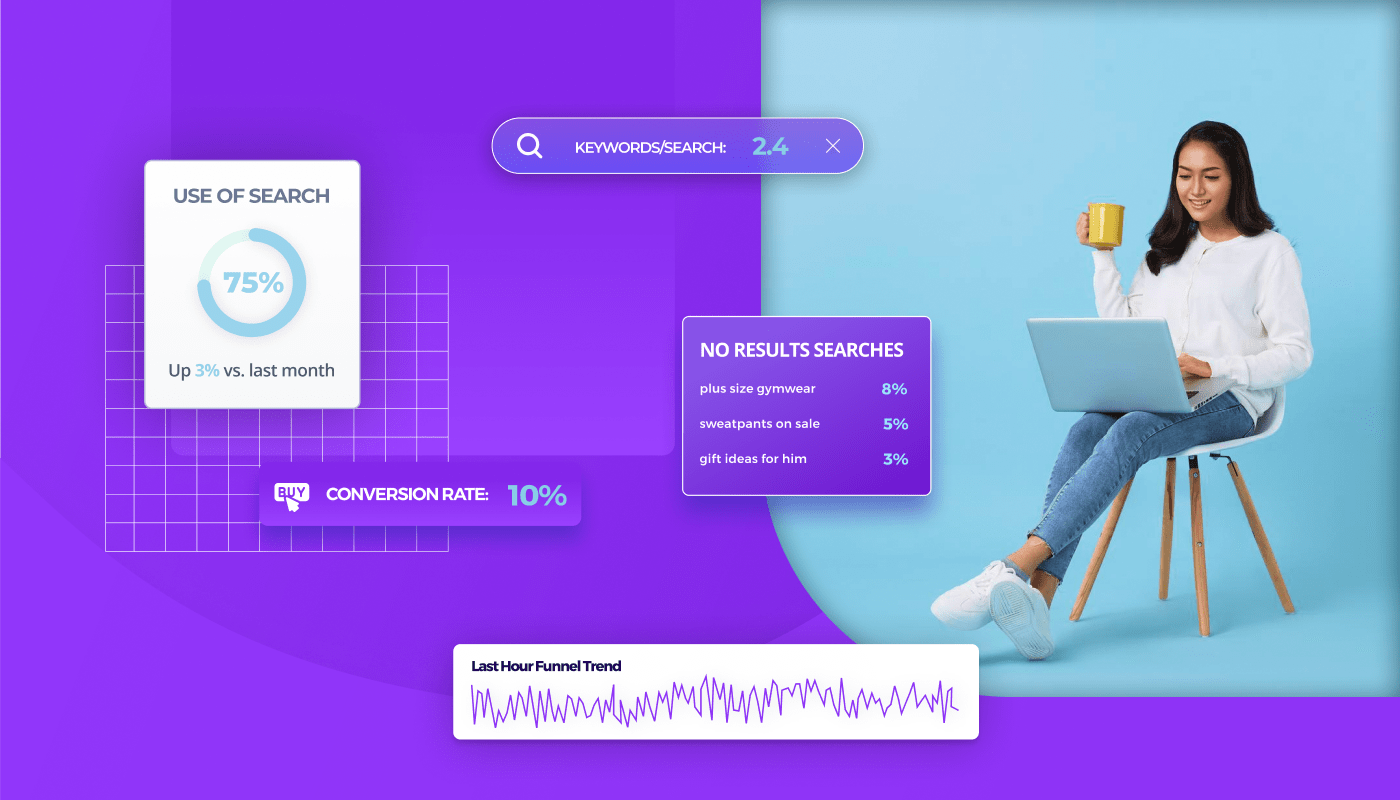Site search is one of the main gateways to product discovery and engagement. From completing the shopper’s query to listing and filtering results, it has many moving parts that can make or break the overall experience. It is essentially the window to the soul of ecommerce.
On retail websites, 43% of visitors go straight to the search box. Searchers also convert 2–3 times more, making site search a critical topic for revenue. As Google and Amazon continue to raise the ‘search bar’ with new features and technologies, many online retailers are investing to catch up and uplift their capabilities.
If you do not want to be left behind, here are 5 areas you need to focus on right now to improve your on-site search:
1. Augment your NLP.
Rule-based search has been around for a while and is effective if you know exactly what you’re looking for. But users don’t always have a clear idea of how to go about their search. With constantly changing search habits, online businesses need more sophisticated tools to understand what shoppers actually need.
As one of the most significant developments in search history, Natural Language Processing (NLP) refers to the analysis and synthesis of natural language and speech using computational methods. Simply put, NLP makes content comprehensible for machines. For instance, searches for “video clip” and “hair clip” both use the word “clip,” but they do so with distinct definitions. Humans can distinguish between these statements based on context, knowing that one of them refers to a part of a video and the other to a hair accessory. It is intuitive and NLP technology provides the means to make such distinctions.
A good NLP basis can decipher even complex queries such as “mens crossfit trainers size 10 blue” extracting key indicators for category, size, color, and purpose.
Typo-tolerance is another important feature that your search engine should deliver. Over 10% of search engine inquiries contain typos. Many product names and brands are hard to spell, and users are likely to make typos when writing them. Typing on mobile devices while being distracted also leads to some creative spellings. Make sure your website’s search is set up to recognize typos and phonetic misspellings so that simple errors don’t lead to a blank results page. Augmenting your NLP to understand typos will decrease friction in your customer’s shopping journey and provide them with a smooth experience.
2. Searchandise.
Adding the merchandising touch to search results is a powerful tool. It allows the business to take control of how and what is showcased in line with internal strategies. Searchandising refers to the practice of curating search results to boost conversions and profitability. Product owners, marketers, and merchandisers can arrange search results in ways that support their objectives and complement them with relevant promotional elements.
For searchandising to function, business-specific rules are layered over the basic relevance criteria in displaying search results.
This enables you to promote, boost, or bury products for specific search phrases, adapting dynamically to business objectives. For instance, you can prioritize new arrivals and high-margin items higher up in the results. Similarly, you can downgrade low inventory items so you don’t run out of stock. This way you achieve the optimal combination of what is the most relevant for the customer and what works best for your business.
Other components on the results page such as promo banners and popups can also be customized based on specific search keywords. Most ecommerce companies use static banners that highlight mass promotions or free shipping offers. It can be a true differentiator to customize the promotional content to better align it with search intent.
3. Personalize results.
Not all visitors that search with the same keyword are looking for the same item. Among those searching for “glasses”, for example, some might prioritize style, others durability and others may be newcomers and want to browse as many options as possible. Personalization is an important factor in maximizing relevance and shortening conversion times. It can help customers reach products of interest without wasting valuable time.
A good search engine should differentiate between customer profiles using inputs such as demographics, preferences, and behavior.
Search engines can reveal relevant options more quickly by limiting results based on what similar customers have looked for and clicked on. Additionally, by drawing on past searches and browsing history, personalized suggestions can show up as users type their search queries. Personalizing what each customer sees first can greatly impact conversions and satisfaction. By incorporating machine learning algorithms into your search engine, you can figure out what your customers want and display exactly that for them.
4. Empower the user.
Through personalization, you can provide a selection of items based on your customer’s needs. But even the best search engine cannot read the customer’s mind. That’s why it is important to equip the shopper with easy-to-use tools to further narrow down results. This is where facets play an important role.
Facets, also known as smart filters, are a form of a search filter that is intended to assist users in quickly narrowing down their search results. Facets can change dynamically depending on the context of the search query, as opposed to static filters that remain the same for every search. For instance, searching for “watches” and “computers” will result in different filtering choices in an on-site search bar. Watches might include filters like cord type and frame color whilst computers might include filters like screen size and hard disk capacity.
Facets can have a significant impact on user experience and consumer perception as well as your site’s overall conversion rate.
Facets can be created from practically any attribute on your site. Facets can also appear in a variety of ways, including sliders, tag clouds, tabs, checkboxes, and more. Keep in mind that, although facets help customers narrow down their search, users may find too many facets intimidating and too few frustrating. Find the right balance between what you have and the needs of your audience.
Data quality plays a huge role in creating easy-to-use facets. Especially in marketplaces, where there are many variations of features like size options, filtering can turn into a hassle. Having to select multiple versions of ‘SMALL’ size such as ‘S’, ‘small’, or ‘s’ completely defeats the purpose. Make sure your product data is up to par before implementing each facet and check out these recommendations for quick ways to improve your data quality.
5. Prioritize mobile.
Mobile commerce has become the leading choice among all available shopping channels. By 2025, it is anticipated that global mobile spending will reach $728 billion. With this solid growth over the years, it is critical to place extra emphasis on the mobile search experience. Site search is preferred by 70% of mobile customers over site navigation and organic search.
Mobile users are 75% more likely than desktop users to leave a website as a result of a subpar search experience.
Mobile search experience differs from desktop due to many factors like screen size and usage habits. Mobile search has to work well with less concentration, fewer motions, and possibly while on the move. That is why user flows and experience elements of mobile search deserve special attention.
There are several ways in which you can craft a lean and smooth mobile search experience. To start, put the search box where a mobile user would expect to see it. Make sure that the results are visible and digestible. By enabling auto-suggestion, less typing is required from your customers, which can be tedious on a smaller screen. An irrelevant pop-up, notification, or incorrect button click can quickly turn users away. Make sure the size of buttons and search results are suitable for mobile to avoid clicking mistakes. Eliminate notifications and irrelevant popups to avoid disturbances.
Final Thoughts
According to Google Cloud, consumers typically spend 15 minutes and an average of 6 clicks searching for a specific item on a retail website. And if they cannot find what they’re looking for, they look elsewhere. To effectively capture this ‘I-want-to-buy-moment’, your on-site search engine needs to be super-fast and relevant.
Incorporating intelligence to clearly understand shopper intent and personalize results can drastically improve your conversion rates. Empower users with search tools and prioritize their mobile experience. With smart technologies that understand your unique business needs, you can speed up the process and make a bigger impact.



